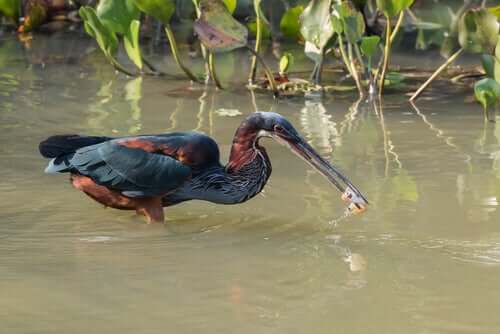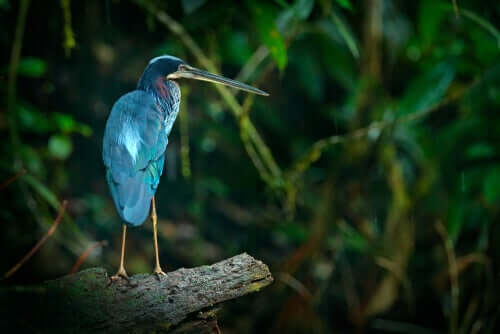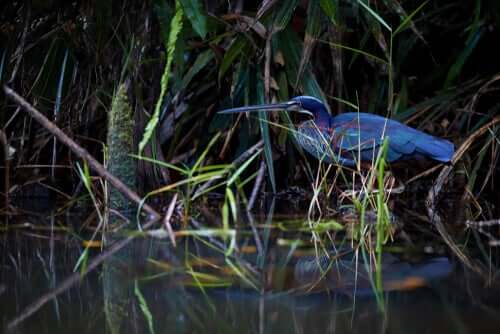The Agami Heron: Habitat and Characteristics

The agami heron is a unique bird that lives in the lowlands and swamp forests of Central America and northern South America. It’s extremely rare to spot one because of their tendency to stay still for long periods.
In general, the agami heron is a solitary bird that prefers to stay away from others members of its species. But, during their mating season, agami herons will reproduce together in colonies of up to 900 nests. This happens during the rainy season, when the lowlands start to flood.
Despite the efforts of much research, the agami heron remains an enigma to us. There are very few known colonies of them, because their habitat is difficult for us to reach. That has prevented researchers from figuring out their population density, though we know enough to know that it’s a vulnerable species.
Distinctive characteristics of the agami heron
An adult is about 25 inches tall, and weighs just over one pound. Like many other swamp and marshland birds, these have extremely long legs which allow them to walk through flooded areas.

They have orange eyes with some tinges of red. Their beaks are always a grayish shade of green. This species of heron also has a long thin neck and beak to make it easier to catch small prey.
Oddly enough, an agami heron’s feathers don’t stay the same color all year round. Most of the time, their heads are black, with short, dark gray feathers around their necks. Their necks are brown, with a chestnut and white band from the front of their necks down to their chests.
Once the mating season begins, both males and females grow longer light blue-gray feathers around their neck. It may not be a drastic change, but it has the desired effect. The newly light feathers on their neck create a contrast with their dark bodies, making it look like the reflection of the sun in the water. This makes them even harder to spot.
Distribution and habitat
The agami heron is a tropical bird that lives especially along the Caribbean coasts in Central America. They also live in northern South America, throughout almost the entire Amazon rainforest.
They can be found in Mexico, Guatemala, Belize, El Salvador, Honduras, Nicaragua, Panama, Colombia, Ecuador, French Guayana, Venezuela, Peru, Bolivia, and Brazil.

In Central America, they mostly live near mangrove forests and freshwater gallery forests near the coast. These kinds of environments are perfect for agami herons because they like to stay hidden in low-lying brush. In the Amazon, they tend to live around f reshwater swamps, like the prairies that flood during the rainy season.
They mostly eat small fish and vertebrates like frogs and lizards. In some cases, they may eat things like snails. That being said, fish are ideally their main source of food. Their hunting technique involves staying motionless for a long time, so that fish swim near their legs. Once the fish is close enough, they quickly snap them up with their long beaks.
Although they tend to stay close to sea level, some research teams have spotted agami herons near the Andes mountain range. They were at an altitude of 8,500 feet.
Right now, the agami heron is classified as a vulnerable species. Deforestation and climate change have drastically changed their habitats, putting the whole species at risk. This also means that spotting them, which was already rare, is only becoming more and more unlikely. See if you can spot one if you’re ever on a trip to Central America!
All cited sources were thoroughly reviewed by our team to ensure their quality, reliability, currency, and validity. The bibliography of this article was considered reliable and of academic or scientific accuracy.
- Stier, A., Ricardou, A., Uriot, S., De Pracontal, N., & Kushlan, J. A. (2017). Breeding season home range and migration of the Agami Heron (Agamia agami). Waterbirds, 40(3), 289-297.
- Abella-Gutiérrez, I., & López-Conlon, M. (2008). Fenología reproductiva de una colonia de Garza Agami (Agamia agami, Aves: Ardeidae) en la Reserva Pacuare, Costa Rica. Brenesia, 69, 77-79.
- Kushlan, J. A., & Hines, K. (2016). Behavior of the Agami Heron (Agamia agami). Waterbirds, 39(2), 187-193.
